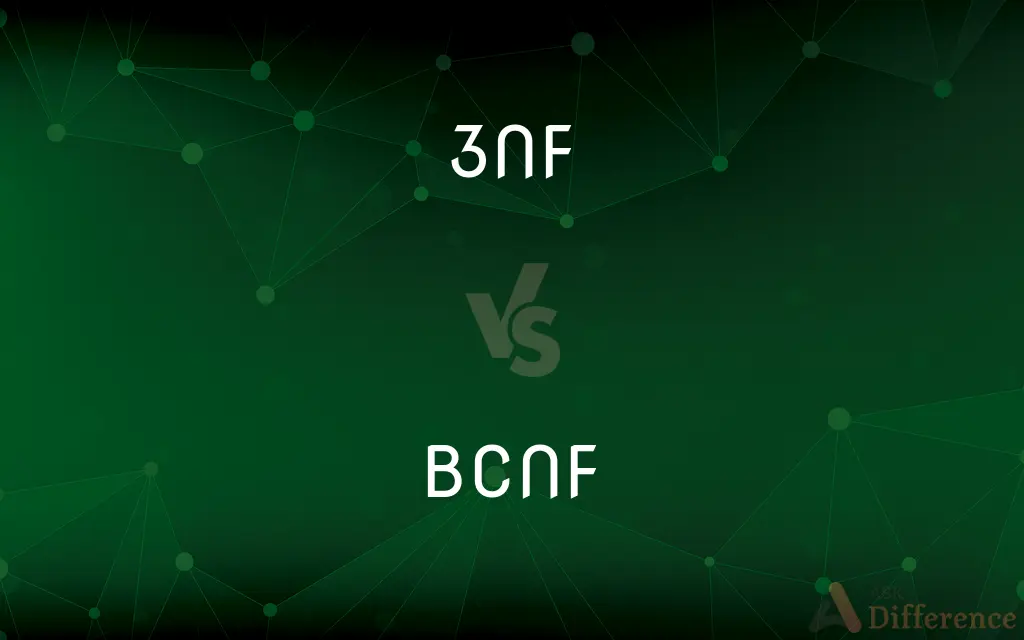3NF vs. BCNF — What's the Difference?
By Tayyaba Rehman — Published on January 7, 2024
3NF is a normal form that eliminates transitive dependency from a database table, whereas BCNF is a stricter form that resolves ambiguities in functional dependency representation.

Difference Between 3NF and BCNF
Table of Contents
ADVERTISEMENT
Key Differences
In database theory, 3NF, or Third Normal Form, is focused on eliminating transitive dependencies from a relational database table to increase data integrity. BCNF, or Boyce-Codd Normal Form, is a further enhancement of 3NF that deals with certain types of functional dependencies that are not addressed by 3NF.
3NF ensures that every non-prime attribute is non-transitively dependent on every key of the database table. BCNF goes beyond 3NF by handling anomalies due to functional dependencies, ensuring that the table structure can handle logical consistency for multiple candidate keys.
A database table is in 3NF if it is in Second Normal Form (2NF) and all the attributes that are not part of any candidate key depend directly on the primary key. BCNF tightens this condition further by ensuring that every determinant is a candidate key, which can become significant in tables with complex relationships between attributes.
Both 3NF and BCNF aim to reduce redundancy and dependency in a database system. However, BCNF is more rigorous and can sometimes demand a level of normalization that may not be practical for all database scenarios. While 3NF eliminates functional dependencies on a subset of a candidate key, BCNF ensures that there are no non-trivial dependencies at all except on a superkey.
While 3NF is often sufficient for most practical database designs, BCNF is used when the table has more complex relationships and potential anomalies that 3NF does not resolve. Although BCNF is a stricter form, it is not always necessary or practical to achieve BCNF in every database.
ADVERTISEMENT
Comparison Chart
Dependency Rules
No transitive dependencies on candidate keys
No dependencies except on a superkey
Handling of Functional Dependencies
Eliminates those on a subset of a candidate key
All non-trivial dependencies are on superkeys
Complexity
Less complex than BCNF
More complex due to stricter rules
Anomalies Addressed
Some anomalies addressed
All anomalies addressed, even with multiple candidate keys
Practical Use
Often adequate for most databases
Used when 3NF is not enough to remove anomalies
Compare with Definitions
3NF
Eliminates transitive dependencies in relational databases.
Our customer database was normalized to 3NF to improve data integrity.
BCNF
Refines 3NF by resolving more complex functional dependencies.
To address our database's multi-key complexities, we advanced the design to BCNF.
3NF
Ensures non-prime attributes are dependent on the primary key.
After restructuring the table, each non-prime attribute was fully functional on the primary key, achieving 3NF.
BCNF
Can lead to more tables than 3NF due to stricter normalization.
Our normalization to BCNF resulted in additional tables due to its stricter constraints.
3NF
Enhances database structure for integrity and efficiency.
Our database's transition to 3NF greatly enhanced its operational efficiency.
BCNF
Requires every determinant to be a candidate key.
The table reached BCNF since every determinant we identified was also a candidate key.
3NF
Reduces data redundancy in relational databases.
3NF normalization helped us reduce redundant data storage.
BCNF
Often used for highly normalized database designs.
For our critical financial data, we employed BCNF to ensure the highest level of data normalization.
3NF
Third stage in the database normalization process.
We progressed the schema from 2NF to 3NF to prevent update anomalies.
BCNF
Addresses anomalies in relations with more than one candidate key.
BCNF was necessary for our multi-candidate key relations to prevent insertion anomalies.
Common Curiosities
What does 3NF stand for?
Third Normal Form.
Why is 3NF important in databases?
It improves data integrity by removing transitive dependencies.
Can a table be in BCNF and not in 3NF?
No, if a table is in BCNF, it is also in 3NF by definition.
What does BCNF stand for?
Boyce-Codd Normal Form.
Can BCNF result in a loss of functional dependencies?
If not done carefully, it can decompose relations that lose certain dependencies.
How does BCNF differ from 3NF?
BCNF is stricter, removing all anomalies that 3NF does not.
What kind of dependencies are addressed by BCNF?
BCNF addresses all non-trivial functional dependencies.
Is it always necessary to achieve BCNF?
Not always; it depends on the specific requirements and structure of the database.
How is redundancy affected by 3NF?
Redundancy is greatly reduced in 3NF.
Does BCNF always require more tables than 3NF?
Not always, but it is more likely due to its stricter rules.
Are update anomalies still possible in 3NF?
Some update anomalies may persist, which BCNF can address.
How does 3NF improve query performance?
By reducing redundancy, 3NF can make queries more efficient.
Is 3NF sufficient for most databases?
Yes, 3NF is often sufficient for most practical database designs.
Is BCNF better than 3NF?
"Better" is context-dependent; BCNF is stricter, but not always necessary.
Do I need to normalize to BCNF for every database?
No, BCNF should be applied based on the complexity and specific needs of the database.
Share Your Discovery

Previous Comparison
Jack Daniel’s vs. Bourbon
Next Comparison
Barcode vs. QR CodeAuthor Spotlight
Written by
Tayyaba RehmanTayyaba Rehman is a distinguished writer, currently serving as a primary contributor to askdifference.com. As a researcher in semantics and etymology, Tayyaba's passion for the complexity of languages and their distinctions has found a perfect home on the platform. Tayyaba delves into the intricacies of language, distinguishing between commonly confused words and phrases, thereby providing clarity for readers worldwide.
















































